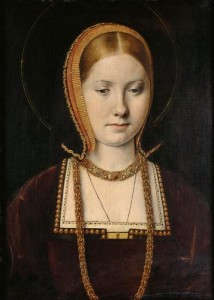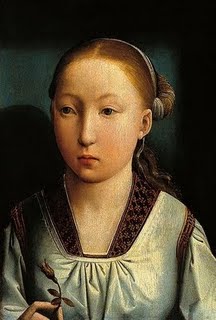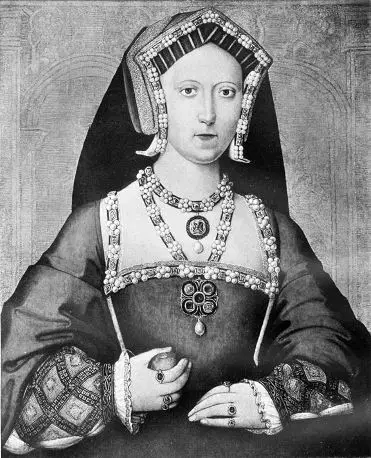
Thank you so much to Nasim Tadghighi for bringing this re-identification of Michel Sittow’s portrait to my attention and for writing this article which explains how it came about. Both Nasim and I would love to hear your thoughts on this too. Over to Nasim…
Two weeks ago my sister travelled to Vienna and visited the Kunsthistorisches Museum. Fortunately she came back with various postcards and holiday snaps of the places and items she knew would be of interest to me. This included an image of a painting by the sixteenth-century Estonian artist, Michel Sittow, known to many as a portrait of a young Katherine of Aragon [Figure 1].1 But I noticed that the museum had labelled the portrait as “Mary ‘Rose’ Tudor”, daughter of Henry VII, sister of Henry VIII, consort of Louis XII of France, and grandmother of Lady Jane Grey (amongst many other connections). This re-identification has been little commented upon which is particularly surprising considering current interest in Tudor portraiture, and in the dynasty as a whole.
Given the painting’s long association with Katherine of Aragon an argument contradicting this will be met with some wariness, even strong opposition. For many, this is an iconic image of the young and reputedly beautiful Katherine. A Katherine before the strain of widowhood, before the tragedy of multiple failed pregnancies and the breakdown of her marriage to Henry VIII. The portrait was even included in the British Library’s 2009 exhibition, Henry VIII: Man and Monarch, marking the 500th anniversary of this monarch’s accession. There the portrait was presented as “The Young Katherine of Aragon” around c. 1504-5.2 Yet the previous year an article was published that challenged the argument it was Katherine, proposed it was of another prominent lady, and was so successful in its assertions that the Kunsthistorisches Museum rejected the Katherine tradition.
Following the discovery that the portrait is no longer believed to be Henry VIII’s first wife, I emailed the museum for further details. They were extremely helpful, and sent me the influential article – Paul G. Matthews, “Henry VIII’s Favourite Sister? Michel Sittow’s Portrait of a Lady in Vienna”, Jahrbuch der Kunsthistorischen Museums Wien 10 (2008), pp. 140-149. Matthews completed his PhD thesis, “Masks of Authority: Charles V and State Portraiture at the Habsburg Courts, c.1500-1533”, at the University of Cambridge in 2003. Since then he has published several articles on the Habsburgs and art, as well as work in connection to the Dulwich Picture Gallery.3
In the article, Matthews notes that the portrait’s association with Katherine began in 1915 when this identification was proposed by Max Friedländer.4 Friedländer’s paper concerned a painting of the Madonna and Child that had recently been acquired by the Kaiser-Friedrich-Museum (now the Bode Museum).5 The sitter in the painting bore a resemblance to the young woman in the Sittow portrait (whom Friedländer identified throughout as “Michel”; the artist’s precise identification as “Sittow” came about later). Friedländer argued that “Michel” was a favourite portrait artist at the court of Isabella I of Castile, narrowing down the woman’s identity to a member of this queen’s family.6 The fact that the sitter in the portrait has a “C” on her bodice, and wears a collar depicting “K”s and Tudor roses led Friedländer to the conclusion that it was of Isabella’s youngest daughter, Katherine, then engaged to Henry VII’s eldest son, Arthur, Prince of Wales (Friedländer mistakenly calls him Edward).7
It is a view that has stuck. Matthews goes on to state that the first to identify “Michel” as Michel Sittow was Gustav Glück in 1933.8 As Matthews notes, “as well as attributing the Vienna panel to Sittow, Glück proposed the Vienna portrait had been painted during a hypothetical visit to England”. Glück believed that Michel visited the court of Henry VII in the autumn of 1505, probably in the retinue of the Habsburg envoy, Hermann Rinck, who had travelled to the English court to discuss a union between the widowed Henry VII and Margaret of Austria, daughter of Emperor Maximilian I. By then Katherine was residing in England following her marriage to Prince Arthur and his death only six months after. But “there is no documentary evidence for Sittow’s presence in England and the attribution to him of the portrait of Henry VII is no longer accepted”.9
Where does the challenge to Katherine as the sitter come in? Matthews claims “while Friedländer’s identification and Glück’s chronology have been often accepted, neither has been confirmed by any documentary evidence.”10 Matthews admits he is not the first to be suspicious of the tradition that it is Katherine. Sir Roy Strong has remarked that the young woman looks little like Katherine in later portraits of her. Matthews briefly discusses the existing portraits of Katherine to offer some comparison. He remarks that unfortunately we do not possess an array of images of the young Katherine; “the first secure portraits of her appear in the 1520s”.11 He seems to favour the argument that a portrait by Juan de Flandes does depict a young Katherine due to some comparison he sees in this and later, well known, standardised portraits of her [Figure 2].12 But the Vienna portrait does not match.

Matthews does not reject the argument that the painting is by Sittow, of Sittow’s known connection to Isabella of Castile, later to her son-in-law, Philip of Burgundy, and thus to the Habsburgs. Therefore the woman in the portrait is either a Habsburg or associated with the dynasty in some notable way. This is where Mary Tudor comes in. Mary, daughter of Henry VII, was betrothed to the future Charles V in 1508 and “from this date Mary was known at the English court as the “princess of Castile”.”13
Matthews states that following her betrothal to the future Holy Roman Emperor and King of Castile and Aragon, Mary was given a number of presents. This included “a large piece of jewellery from Charles: a ‘K’ for ‘Karolus’ garnished with diamonds and pearls which was inscribed ‘Maria optimam partem elegit, que non auferetur ab ea’ (‘Mary has taken the best part, no one shall take it from her’), a quotation of Luke 10:41 in which Jesus praises the English princess’ namesake”.14 Do the ‘K’s that adorn the sumptuous golden collar of the sitter actually stand for Charles, and not Katherine? Matthews elaborates that “there was a Burgundian tradition of women wearing propriety jewellery” and even brings in a comparison closer to home.15 In the 1520s Mary Tudor’s niece Princess Mary (later Queen Mary I), also found herself engaged to Charles. In a miniature by Lucas Horenbout, Princess Mary is depicted wearing a brooch inscribed “The Empour” (a title that Charles had been elected to by that date).16
But why has the portrait been dated to c. 1514 if the betrothal dates to late 1508? Matthews points out that Sittow was in Habsburg service again between 1513 and 1516.17 Arrangements for a meeting between Charles and Mary were being discussed in late 1513.This never materialised, Henry VIII became angry about the stalling of events prompting measures by the Imperialists to pacify the English King.18 This included sending Seigneur de la Roche to London, who in June 1514 wrote back to Margaret of Austria claiming he had met Mary, who regarded herself as still promised to Charles and, importantly, that a portrait of Mary had been completed.19 If we accept that Sittow was the artist, and there is no reason to reject this artist’s identity, then this means Sittow was in England at this time to paint Mary. Though Matthews previously notes that there is no evidence for Sittow being in England during Henry VII’s reign (so could not have painted Katherine in England by that point), he does think a later date of 1514 is possible. Sittow was certainly travelling around by this stage, for it is assumed he went to Denmark to paint Christian II who was betrothed to one of Charles’s sisters. “Therefore, as Sittow was travelling abroad in order to make the betrothal portraits for the Habsburgs, it seems possible that he was he painter being referred to” in this diplomat’s letter.20
So is this Mary? Matthews considers other portraits of her, but points out that many of the images said to be of her tend to contradict one another (in that they appear not to represent the same woman!). Furthermore the well known double-portrait of Mary and her second husband Charles Brandon, duke of Suffolk, is not a contemporary likeness; worse still, it “seems to be several steps removed from a life sitting, a situation made worse by later overpainting” so we shouldn’t base our opinions of her appearance on this alone.21 What can we rely on? Matthews claims the only image that can certainly be dated to her lifetime is a portrait by Joannus Corvus in Sudeley Castle, though we do not know whether Mary sat for Corvus, if it was based on other images of her, or whether it has been overpainted (and how many times at that) [Figure 3].

To enforce his argument that it is Mary, Matthews claims the idea it is Katherine makes less sense when we consider the sitter’s clothing. “It was the custom that upon betrothal princesses would adopt the national dress of their partners – Henry VIII is documented as wanting Mary’s wedding dress to be in Burgundian fashion, sending swatches of fabric to Margaret of Austria for her approval so if the sitter were Catherine of Aragon it would be logical that she would be portrayed in either English or Spanish dress”.22 Matthews believes the sitter’s dress is very similar to the fashion worn by Charles’s sisters in certain respective portraits of them. He also claims that a portrait of Charles’s sister Margaret (only copies of which exists), “displays the same pilgrim’s shells that can be seen in the Vienna portrait. Indeed, even more telling against the identification of the sitter as Catherine of Aragon is that her symbol was not the scallop shell but the pomegranate”.23 (If you look closely, the shells adorn the edge of the sitter’s bodice).
One criticism of Matthew’s argument is the lack of reference to a portrait of Mary by Sittow in Margaret of Austria’s inventory of 1516. Matthews addresses this absence by saying the portrait probably was with Margaret’s father, and Charles’s grandfather, Maximilian I. Maximilian became interested in marrying Mary in 1515 following the death of Mary’s husband Louis XII of France (and evidently before knowledge of her hasty marriage to the duke of Suffolk became public knowledge). It is possible the portrait was completed back in 1514, never sent because the Mary and Charles match broke off shortly after the painting was finished, but was then sent to Maximilian when once again there was talk of a marriage alliance between the Tudors and the Habsburgs. We know Maximilian possessed a portrait of Mary, and reputedly gazed at it for at least half-an-hour, though all talk of marriage came to nothing when Mary’s union with the duke of Suffolk was revealed. This, Matthew says, explains why the portrait ended up in the Habsburg collection.
So to summarise this already too long article(!), Matthews believes it is of Mary, the reputedly beautiful Tudor princess, for several key reasons:
- The lack of contemporary evidence supporting the initial assumption it was Katherine.
- That the ‘K’s on the sitter’s collar stand for Mary’s betrothed Charles, and that Mary was in receipt of similar items of jewellery. It was also “a custom for the brides of Burgundian princes to wear proprietary jewellery”.
- The sitter wears similar dress to Charles’s aunt and sisters. Katherine would have had no reason to wear such attire. The inclusion of shells on the sitter’s dress can also not be connected to Katherine.
- A Habsburg artist certainly painted Mary in 1514. Sittow was in Habsburg employment by that time and travelling for various commissions.
These conclusions evidently convinced the Kunsthistorisches Museum. But will his arguments find favour amongst Tudor scholars and other enthusiasts? Perhaps one way forward is dendrochronological dating that can answer the question of whether it does date to c. 1514. But I suspect that even if such tests were done, and proved to support Matthew’s argument, the idea it is not a young Katherine of Aragon will still be one some find hard accepting.
Notes and Sources
- “Mary Rose Tudor (?)”, by Michel Sittow, c. 1514. Kunsthistorisches Museum, Vienna. Inv. Nr. 5612.
- Susan Doran (ed.), Henry VIII: Man and Monarch (London: The British Library, 2009), p. 59, entry 44. I think this was the last time the portrait was exhibited in the UK.
- For more information on Matthews’s work see this (apparently personal) site: http://allisonandpaul.com/Paul.html
- Max J. Friedländer, “Gemäldegalerie. Ein neu erworbenes Madonnenbild im Kaiser-Friedrich-Museum”, Amtliche Berichte aus den Königlichen Kunstammlungen, 36, 9 (1915), pp. 1-4.
- “Virgin and Child”, by Michel Sittow, c. 1515-8. Gemäldegalerie Staatliche Museen, Berlin.
- Ibid, p. 20.
- Ibid, p. 21.
- Gustav Glück, “The ‘Henry VII’ in the National Portrait Gallery”, The Burlington Magazine, LXIII (1933), pp. 100-8
- Matthews, “Henry VIII’s Favourite Sister?”, p. 143.
- Ibid.
- Ibid.
- “Portrait of an Infanta. Catherine of Aragon(?)”, by Juan de Flandes, c. 1496. Museo Thyssen-Bornemisza, Madrid.
- Ibid.
- Ibid.
- Ibid.
- “Queen Mary I”, attributed to Lucas Horenbout, c. 1521-5. National Portrait Gallery, London.
- Ibid., p145
- Ibid.
- Ibid, pp. 145-6.
- Ibid, p. 146.
- Ibid.
- Ibid, pp. 146-7.
- Ibid, p. 147.